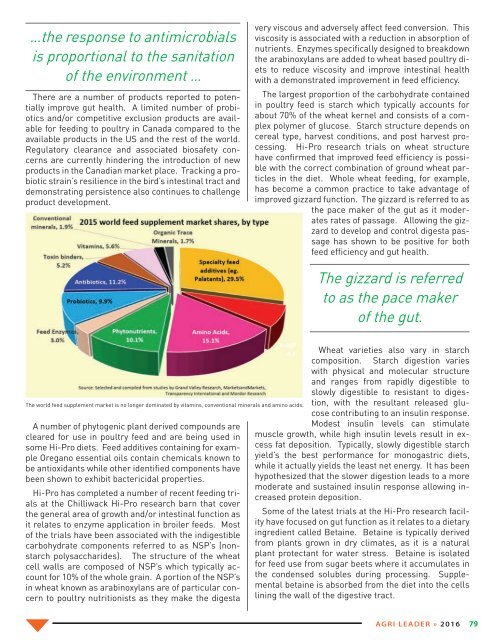You also want an ePaper? Increase the reach of your titles
YUMPU automatically turns print PDFs into web optimized ePapers that Google loves.
…the response to antimicrobials<br />
is proportional to the sanitation<br />
of the environment …<br />
There are a number of products reported to potentially<br />
improve gut health. A limited number of probiotics<br />
and/or competitive exclusion products are available<br />
for feeding to poultry in Canada compared to the<br />
available products in the US and the rest of the world.<br />
Regulatory clearance and associated biosafety concerns<br />
are currently hindering the introduction of new<br />
products in the Canadian market place. Tracking a probiotic<br />
strain’s resilience in the bird’s intestinal tract and<br />
demonstrating persistence also continues to challenge<br />
product development.<br />
very viscous and adversely affect feed conversion. This<br />
viscosity is associated with a reduction in absorption of<br />
nutrients. Enzymes specifically designed to breakdown<br />
the arabinoxylans are added to wheat based poultry diets<br />
to reduce viscosity and improve intestinal health<br />
with a demonstrated improvement in feed efficiency.<br />
The largest proportion of the carbohydrate contained<br />
in poultry feed is starch which typically accounts for<br />
about 70% of the wheat kernel and consists of a complex<br />
polymer of glucose. Starch structure depends on<br />
cereal type, harvest conditions, and post harvest processing.<br />
Hi-Pro research trials on wheat structure<br />
have confirmed that improved feed efficiency is possible<br />
with the correct combination of ground wheat particles<br />
in the diet. Whole wheat feeding, for example,<br />
has become a common practice to take advantage of<br />
improved gizzard function. The gizzard is referred to as<br />
the pace maker of the gut as it moderates<br />
rates of passage. Allowing the gizzard<br />
to develop and control digesta passage<br />
has shown to be positive for both<br />
feed efficiency and gut health.<br />
The gizzard is referred<br />
to as the pace maker<br />
of the gut.<br />
The world feed supplement market is no longer dominated by vitamins, conventional minerals and amino acids.<br />
A number of phytogenic plant derived compounds are<br />
cleared for use in poultry feed and are being used in<br />
some Hi-Pro diets. Feed additives containing for example<br />
Oregano essential oils contain chemicals known to<br />
be antioxidants while other identified components have<br />
been shown to exhibit bactericidal properties.<br />
Hi-Pro has completed a number of recent feeding trials<br />
at the Chilliwack Hi-Pro research barn that cover<br />
the general area of growth and/or intestinal function as<br />
it relates to enzyme application in broiler feeds. Most<br />
of the trials have been associated with the indigestible<br />
carbohydrate components referred to as NSP’s (nonstarch<br />
polysaccharides). The structure of the wheat<br />
cell walls are composed of NSP’s which typically account<br />
for 10% of the whole grain. A portion of the NSP’s<br />
in wheat known as arabinoxylans are of particular concern<br />
to poultry nutritionists as they make the digesta<br />
Wheat varieties also vary in starch<br />
composition. Starch digestion varies<br />
with physical and molecular structure<br />
and ranges from rapidly digestible to<br />
slowly digestible to resistant to digestion,<br />
with the resultant released glucose<br />
contributing to an insulin response.<br />
Modest insulin levels can stimulate<br />
muscle growth, while high insulin levels result in excess<br />
fat deposition. Typically, slowly digestible starch<br />
yield’s the best performance for monogastric diets,<br />
while it actually yields the least net energy. It has been<br />
hypothesized that the slower digestion leads to a more<br />
moderate and sustained insulin response allowing increased<br />
protein deposition.<br />
Some of the latest trials at the Hi-Pro research facility<br />
have focused on gut function as it relates to a dietary<br />
ingredient called Betaine. Betaine is typically derived<br />
from plants grown in dry climates, as it is a natural<br />
plant protectant for water stress. Betaine is isolated<br />
for feed use from sugar beets where it accumulates in<br />
the condensed solubles during processing. Supplemental<br />
betaine is absorbed from the diet into the cells<br />
lining the wall of the digestive tract.<br />
AGRI LEADER » 2016<br />
79


